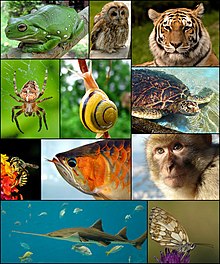| Centroneuralia Temporal range:
| |
|---|---|

| |
| Diversity of centroneuralians, showcasing vertebrates ( Chordata), mollusks ( Protostomia, Spiralia) and arthropods ( Protostomia, Ecdysozoa) | |
|
Scientific classification
| |
| Domain: | Eukaryota |
| Kingdom: | Animalia |
| Subkingdom: | Eumetazoa |
| Clade: | ParaHoxozoa |
| Clade: | Bilateria |
| Clade: |
Centroneuralia Telford, 2021 |
| Clades | |
Centroneuralia is a proposed clade of animals with bilateral symmetry as an embryo, consisting of the Chordata and Protostomia, united by the presence of a central nervous system. An alternative to the traditional protostome- deuterostome dichotomy, it has found weak support in several studies. Under this hypothesis, Centroneuralia would be sister to Xenambulacraria ( Xenacoelomorpha + Ambulacraria) at the base of Bilateria. [1] [2] [3] [4]
Centroneuralia, as a proposed clade, originates in phylogenomics. More precisely, recent studies correlate support for Deuterostomia with simpler, site-homogeneous models, while more sophisticated and site-heterogeneous models recover Centroneuralia more often. [1]
Phylogeny
| Bilateria |
| ||||||
References
- ^ a b Kapli, Paschalia; Natsidis, Paschalis; Leite, Daniel J.; Fursman, Maximilian; Jeffrie, Nadia; Rahman, Imran A.; Philippe, Hervé; Copley, Richard R.; Telford, Maximilian J. (2021-03-19). "Lack of support for Deuterostomia prompts reinterpretation of the first Bilateria". Science Advances. 7 (12): eabe2741. Bibcode: 2021SciA....7.2741K. doi: 10.1126/sciadv.abe2741. ISSN 2375-2548. PMC 7978419. PMID 33741592.
- ^ Marlétaz, Ferdinand; Peijnenburg, Katja T.C.A.; Goto, Taichiro; Satoh, Noriyuki; Rokhsar, Daniel S. (2019-01-21). "A New Spiralian Phylogeny Places the Enigmatic Arrow Worms among Gnathiferans". Current Biology. 29 (2): 312–318.e3. Bibcode: 2019CBio...29E.312M. doi: 10.1016/j.cub.2018.11.042. PMID 30639106.
- ^ Philippe, Hervé; Poustka, Albert J.; Chiodin, Marta; Hoff, Katharina J.; Dessimoz, Christophe; Tomiczek, Bartlomiej; Schiffer, Philipp H.; Müller, Steven; Domman, Daryl; Horn, Matthias; Kuhl, Heiner (2019-06-03). "Mitigating Anticipated Effects of Systematic Errors Supports Sister-Group Relationship between Xenacoelomorpha and Ambulacraria". Current Biology. 29 (11): 1818–1826.e6. Bibcode: 2019CBio...29E1818P. doi: 10.1016/j.cub.2019.04.009. hdl: 21.11116/0000-0004-DC4B-1. ISSN 0960-9822. PMID 31104936.
- ^ Natsidis, Paschalis (2022-05-28). Systematic errors in phylogenomics with a focus on the major metazoan clade Deuterostomia (PhD). University College London.
| Centroneuralia Temporal range:
| |
|---|---|

| |
| Diversity of centroneuralians, showcasing vertebrates ( Chordata), mollusks ( Protostomia, Spiralia) and arthropods ( Protostomia, Ecdysozoa) | |
|
Scientific classification
| |
| Domain: | Eukaryota |
| Kingdom: | Animalia |
| Subkingdom: | Eumetazoa |
| Clade: | ParaHoxozoa |
| Clade: | Bilateria |
| Clade: |
Centroneuralia Telford, 2021 |
| Clades | |
Centroneuralia is a proposed clade of animals with bilateral symmetry as an embryo, consisting of the Chordata and Protostomia, united by the presence of a central nervous system. An alternative to the traditional protostome- deuterostome dichotomy, it has found weak support in several studies. Under this hypothesis, Centroneuralia would be sister to Xenambulacraria ( Xenacoelomorpha + Ambulacraria) at the base of Bilateria. [1] [2] [3] [4]
Centroneuralia, as a proposed clade, originates in phylogenomics. More precisely, recent studies correlate support for Deuterostomia with simpler, site-homogeneous models, while more sophisticated and site-heterogeneous models recover Centroneuralia more often. [1]
Phylogeny
| Bilateria |
| ||||||
References
- ^ a b Kapli, Paschalia; Natsidis, Paschalis; Leite, Daniel J.; Fursman, Maximilian; Jeffrie, Nadia; Rahman, Imran A.; Philippe, Hervé; Copley, Richard R.; Telford, Maximilian J. (2021-03-19). "Lack of support for Deuterostomia prompts reinterpretation of the first Bilateria". Science Advances. 7 (12): eabe2741. Bibcode: 2021SciA....7.2741K. doi: 10.1126/sciadv.abe2741. ISSN 2375-2548. PMC 7978419. PMID 33741592.
- ^ Marlétaz, Ferdinand; Peijnenburg, Katja T.C.A.; Goto, Taichiro; Satoh, Noriyuki; Rokhsar, Daniel S. (2019-01-21). "A New Spiralian Phylogeny Places the Enigmatic Arrow Worms among Gnathiferans". Current Biology. 29 (2): 312–318.e3. Bibcode: 2019CBio...29E.312M. doi: 10.1016/j.cub.2018.11.042. PMID 30639106.
- ^ Philippe, Hervé; Poustka, Albert J.; Chiodin, Marta; Hoff, Katharina J.; Dessimoz, Christophe; Tomiczek, Bartlomiej; Schiffer, Philipp H.; Müller, Steven; Domman, Daryl; Horn, Matthias; Kuhl, Heiner (2019-06-03). "Mitigating Anticipated Effects of Systematic Errors Supports Sister-Group Relationship between Xenacoelomorpha and Ambulacraria". Current Biology. 29 (11): 1818–1826.e6. Bibcode: 2019CBio...29E1818P. doi: 10.1016/j.cub.2019.04.009. hdl: 21.11116/0000-0004-DC4B-1. ISSN 0960-9822. PMID 31104936.
- ^ Natsidis, Paschalis (2022-05-28). Systematic errors in phylogenomics with a focus on the major metazoan clade Deuterostomia (PhD). University College London.
